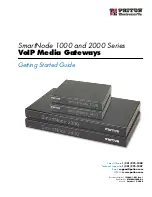
Node, the Gateway generates an RF timeout error in the Modbus I/O register 8 of the appropriate Node.
The ‘Maximum Misses’ is defined as the number of consecutive polling messages that the Node fails to
respond to.
radiation pattern An antenna's radiation pattern is the area over which the antenna broadcasts an easily received signal.
The radiation pattern/shape changes based on the antenna type and gain.
re-link count
The re-link count is the number of completed polling messages the Gateway receives from a Node
before a lost RF link is considered re-established and normal operation resumes.
remote antenna A remote antenna installation is any antenna not mounted directly to the Sure Cross wireless device,
especially when coaxial cable is used. Always properly install and ground surge suppressors in remote
antenna systems.
repeater radio
A repeater radio extends the transmission range of a wireless network. Repeaters are typically used in
long-distance transmission.
report interval/
rate
The report rate defines how often the Node communicates the I/O status to the Gateway. For
Flex
Power
®
applications, setting the report rate to a slower rate extends the battery life.
I/O Status
Change of state reporting sets the system to report only when the value crosses the threshold setting.
rotary dial
address mode
See:
address mode
Received Signal
Strength
Indicator (RSSI)
An RSSI is the measurement of the strength of received signals in a wireless environment. See
Site
Survey
.
resistance
temperature
detector (RTD)
An RTD is a temperature measurement device that measures the electrical resistance across a pure
metal. The most commonly used metal is platinum because of its temperature range, accuracy, and
stability.
RTDs are used for higher precision applications or for longer wire runs because RTDs can compensate
for wire length. In industrial applications, RTDs are not generally used at temperatures above 660º C.
Though RTDs are more accurate, they are slower to respond and have a smaller temperature range than
thermocouples.
sample high/
sample low
(analog I/O)
For analog inputs, the sample high parameter defines the number of consecutive samples the input
signal must be above the threshold before a signal is considered active. Sample low defines the number
of consecutive samples the input signal must be below the threshold minus hysteresis before a signal is
considered deactivated. The sample high and sample low parameters are used to avoid unwanted input
transitions.
sample high/
sample low
(discrete I/O)
For discrete inputs, the sample high parameter defines the number of consecutive samples the input
signal must be high before a signal is considered active. Sample low defines the number of consecutive
samples the input signal must be low before a signal is considered low. The sample high and sample
low parameters are used to create a filter to avoid unwanted input transitions. The default value is 0,
which disables this feature. The value range is 1 through 255.
sample interval/
rate
The sample interval, or rate, defines how often the Sure Cross device samples the input. For battery-
powered applications, setting a slower rate extends the battery life.
Sure Cross
®
Performance DX80 Wireless I/O Networks
64
www.bannerengineering.com - Tel: + 1 888 373 6767






































